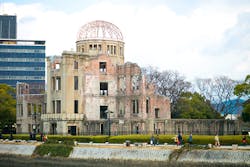The nuclear age was arguably born 75 years ago when, on August 6, 1945, a U.S. B-29 dropped an atomic bomb on the Japanese city of Hiroshima.
Originally coined the atomic age, after the title of a 1945 Pocket Book, The Atomic Age Opens, edited by Gerald L. Wendt, a PhD chemist, writer, lecturer, and science editor, and Donald Porter Geddes, best known for his own 1945 tribute, Franklin Delano Roosevelt, a Memorial. With the advent of hydrogen bombs, the atomic age soon became the nuclear age, and the search for peaceful uses for nuclear energy began in earnest. In 1957, the first commercial nuclear power plant, located in Shippingport, PA, produced full design power.
Nuclear weapons were, of course, controversial from day one. But civilian nuclear power was also not without its critics. Fast forward to now and – as noted in one of June’s Clark’s Remarks – the debate over nuclear power’s safety continues. In that column, the International Atomic Energy Agency was cited as estimating that 50 countries will have nuclear reactors by 2030, with nearly one thousand reactors worldwide in the next 20 years.
That prediction may still be accurate, but American’s appetite for nuclear power may see further decline. Last month, the chairman of the Federal Energy Regulatory Commission (FERC) addressed the long-term impacts of the COVID-19 pandemic, including a decrease in demand for electric energy and concerns over such issues as deferred equipment maintenance. Major utilities, including American Electric Power, Duke Energy, and FirstEnergy, advised the FERC that continued uncertainty over the pandemic remains a "significant threat to the [energy] sector."
One recent example of the pandemic’s impact on nuclear power plants is the significant delay in construction of Georgia Power's Alvin W. Vogtle Electric Generating Plant two-unit expansion. Georgia Power announced that it would be making reductions in staff late into the summer after its contractor reported 42 confirmed COVID-19 cases among construction workers on the project.
All of this comes in the wake of a major scandal involving the nuclear power industry.
Last month, Ohio’s Speaker of the House, Larry Householder, was arrested by the FBI and charged by the US Attorney with bribery in conjunction with the passage of 2019’s House Bill 6. That legislation raised electric rates in Ohio in order to fund a $1.5-billion bailout for two nuclear power plants operated by a bankrupt subsidiary of FirstEnergy, which had claimed that it would be forced to close the plants if it didn’t receive the bailout. According to the charges, the utility gave as much as $61 million dollars to a tax-exempt organization created by Householder, which he then used to help elect legislators that would support the bill. The U.S. Attorney alleges that as much as $10 million was spent to defeat a petition drive that would have put the bailout to a public vote.
Hopefully, the next 75 years will be kinder to nuclear power, as clean, safe fission becomes a reality.
############
A regular contributor to HPAC Engineering and a member of its editorial advisory board, the author is a principal at Sustainable Performance Solutions LLC, a south Florida-based engineering firm focusing on energy and sustainability. Contact him at [email protected].
About the Author
Larry Clark
A member of HPAC Engineering’s Editorial Advisory Board, Lawrence (Larry) Clark, QCxP, GGP, LEED AP+, is principal of Sustainable Performance Solutions LLC, a South Florida-based engineering firm focused on energy and sustainability consulting. He has more than two dozen published articles on HVAC- and energy-related topics to his credit and frequently lectures on green-building best practices, central-energy-plant optimization, and demand-controlled ventilation.
